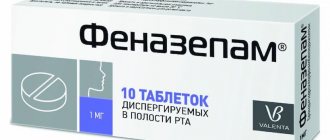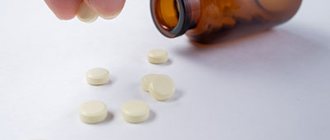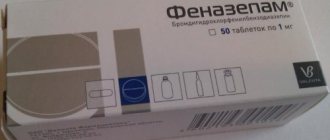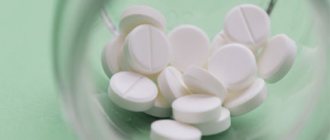Comparison of the effectiveness of Phenazepam and Elzepam
The effectiveness of Phenazepam is quite similar to Elzepam - this means that the ability of the drug substance to provide the maximum possible effect is similar.
For example, if the therapeutic effect of Phenazepam is more pronounced, then using Elzepam even in large doses will not achieve this effect.
Also, the speed of therapy - an indicator of the speed of therapeutic action - is approximately the same for Phenazepam and Elzepam. And bioavailability, that is, the amount of a drug reaching its site of action in the body, is similar. The higher the bioavailability, the less it will be lost during absorption and use by the body.
Addiction
Both medications can be addictive, even when taken under medical supervision . But in order to protect yourself at least a little, you need to follow only the prescription, and in no case increase the dose yourself, as this is a sure path to addiction. You need to stop using drugs gradually and under the supervision of a doctor, as withdrawal syndrome may develop.
Comparison of safety of Phenazepam and Elzepam
The safety of a drug includes many factors.
At the same time, in Phenazepam it is quite similar to Elzepam. It is important where the drug is metabolized: drugs are excreted from the body either unchanged or in the form of products of their biochemical transformations. Metabolism occurs spontaneously, but most often involves major organs such as the liver, kidneys, lungs, skin, brain and others. When assessing the metabolism of Phenazepam, as well as Elzepam, we look at which organ is the metabolizing organ and how critical the effect on it is.
The risk-benefit ratio is when the prescription of a drug is undesirable, but justified under certain conditions and circumstances, with the obligatory observance of caution in use. At the same time, Phenazepam does not have any risks when used, just like Elzepam.
Also, when calculating safety, it is taken into account whether only allergic reactions occur or possible dysfunction of the main organs. In other matters, as well as the reversibility of the consequences of using Phenazepam and Elzepam.
Active substance
Perhaps we’ll start with what these drugs have in common. Elzepam and Phenazepam have the same active ingredient - bromodihydrochlorophenylbenzodiazepine, which reduces emotional stress and helps reduce feelings of fear and anxiety. It is prohibited to take medications containing this substance at the same time with alcohol, drugs, antipsychotics and sleeping pills , since the substance mutually enhances their effect. It should also not be taken together with other tranquilizers.
Here we can compare Phenazepam with Elzepam because the amount of bromodihydrochlorophenylbenzodiazepine in the drugs is different. When one Elzepam tablet contains 0.0089 active substance, which in itself is not small, then a Phenazepam tablet contains 0.242, and this is already 27 times more than in Elzepam. Due to the larger amount of active substance, Phenazepam has a more effective effect on the body, which on the one hand is an advantage, but on the other hand, for the same reasons, the risk of dependence on this drug is also higher.
If you compare the prices of these two drugs, then Elzepam is cheaper than Phenazepam.
Comparison of addiction between Phenazepam and Elzepam
Like safety, addiction also involves many factors that must be considered when evaluating a drug.
So, the totality of the values of such parameters as “syndrome o” for Phenazepam is less than the similar values for Elzepam. Withdrawal syndrome is a pathological condition that occurs after the cessation of intake of addictive or dependent substances into the body. And resistance is understood as initial immunity to a drug; in this it differs from addiction, when immunity to a drug develops over a certain period of time. The presence of resistance can only be stated if an attempt has been made to increase the dose of the drug to the maximum possible.
Indications
Phenazepam and Elzepam have the same indications, as do other drug analogues - Phenorelaxan, Fenzitate, Fezanef:
- deep depression
- insomnia, sleep problems
- constant feeling of fear and anxiety for no reason
- constant irritability, aggression, psychosis
- convulsions
- alcoholism
- post-traumatic shock
Contraindications
- allergy to any components of the drugs
- kidney and liver problems
- pregnancy
- lactation
- myasthenia gravis
- angle-closure glaucoma
- poisoning with alcohol, sleeping pills, narcotic substances
- severe depression
- persons under 18 years of age
Side effects
- feeling tired, drowsiness, dizziness
- slow reaction time, problems concentrating
- headache
- depression
- memory problems
- hallucinations
- outbursts of aggression
- suicidal tendencies
- impaired renal and liver function
- coma
- addiction, dependence
Comparison of side effects of Phenazepam and Elzepam
Side effects or adverse events are any adverse medical event that occurs in a subject after administration of a drug.
Phenazepam has more adverse effects than Elzepam. This implies that the frequency of their occurrence is low with Phenazepam and low with Elzepam. Frequency of manifestation is an indicator of how many cases of an undesirable effect from treatment are possible and registered. The undesirable effect on the body, the strength of influence and the toxic effect of drugs are different: how quickly the body recovers after taking it and whether it recovers at all. When using Phenazepam, the body's ability to recover faster is higher than that of Elzepam.
Let's summarize
So which is better, Elzepam or Phenazepam? There is no exact answer to this question, since the indications, side effects, and contraindications for these drugs are the same. These drugs differ only in their potency. Phenazepam is a stronger drug and is used to treat more severe cases than Elzepam. Your doctor will provide you with a more precise recommendation about which drug to take in certain cases. Do not self-medicate under any circumstances, as this is dangerous to your health. Do not increase the dose on your own, and use these drugs only for medicinal purposes under the supervision of a doctor.
Found a mistake? Select it and press Ctrl + Enter
Comparison of ease of use of Phenazepam and Elzepam
This includes dose selection taking into account various conditions and frequency of doses. At the same time, it is important not to forget about the release form of the drug; it is also important to take it into account when making an assessment.
The ease of use of Phenazepam is approximately the same as Elzepam. However, they are not convenient enough to use.
The drug ratings were compiled by experienced pharmacists who studied international research. The report is generated automatically.
Last update date: 2020-12-13 10:31:30
Phenazepam
Use during pregnancy and breastfeeding
During pregnancy, use is possible only for health reasons.
It has a toxic effect on the fetus and increases the development of birth defects when used in the first trimester of pregnancy. When taken in therapeutic doses later in pregnancy, it may cause CNS depression in the newborn. Chronic use during pregnancy can lead to physical dependence with the development of withdrawal syndrome in the newborn. Children, especially young children, are very sensitive to the CNS depressant effects of benzodiazepines. Use immediately before or during childbirth may cause respiratory depression in the newborn, decreased muscle tone, hypotension, hypothermia and weak sucking ("floppy baby" syndrome).
Use for liver dysfunction
Use with caution in case of liver failure.
Use for renal impairment
Use with caution in case of renal failure.
Use in children
Contraindicated in children and adolescents under 18 years of age (safety and effectiveness have not been determined).
special instructions
Use with caution in case of liver and/or renal failure, cerebral and spinal ataxia, history of drug dependence, tendency to abuse psychoactive drugs, hyperkinesis, organic brain diseases, psychosis (paradoxical reactions are possible), hypoproteinemia, sleep apnea (established or suspected ), in elderly patients.
In case of renal and/or liver failure and long-term treatment, it is necessary to monitor the peripheral blood picture and the activity of liver enzymes.
Patients who have not previously taken psychoactive drugs exhibit a therapeutic response to the use of phenazepam in lower doses compared to patients taking antidepressants, anxiolytics, or alcoholism.
Like other benzodiazepines, it has the ability to cause drug dependence when taken long-term in large doses (more than 4 mg/day). If you suddenly stop taking it, withdrawal symptoms may occur (including depression, irritability, insomnia, increased sweating), especially with long-term use (more than 8-12 weeks). If patients experience unusual reactions such as increased aggressiveness, acute states of agitation, feelings of fear, thoughts of suicide, hallucinations, increased muscle cramps, difficulty falling asleep, shallow sleep, treatment should be discontinued.
During treatment, patients are strictly prohibited from consuming ethanol.
The effectiveness and safety of the drug in patients under 18 years of age have not been established.
In case of overdose, severe drowsiness, prolonged confusion, decreased reflexes, prolonged dysarthria, nystagmus, tremor, bradycardia, shortness of breath or difficulty breathing, decreased blood pressure, and coma are possible. Gastric lavage and activated charcoal are recommended; symptomatic therapy (maintaining breathing and blood pressure), administration of flumazenil (in a hospital setting); hemodialysis is ineffective.
Impact on the ability to drive vehicles and operate machinery
During the treatment period, care must be taken when driving vehicles and engaging in other potentially hazardous activities that require increased concentration and speed of psychomotor reactions.
Contraindications
- Depression of consciousness: stupor, stupor, coma.
- Shock.
- Poisoning with sleeping pills.
- Cardiovascular and pulmonary failure.
- Allergy and intolerance to phenazepam.
During pregnancy and childhood, taking the drug is determined individually; there are no clear contraindications.
Phenazepam is widely used in the practice of doctors of many specialties. It is prescribed by psychiatrists, psychotherapists, neurologists, psychiatrists - narcologists, therapists, cardiologists, gynecologists and others.
Since March 22, 2021, by Decree of the Government of the Russian Federation No. 1495, bromodigrochlorophenylbenzodiazepine (phenazepam) has been included in the list of potent substances and is therefore subject to subject-quantitative accounting. This caused a restriction of its spread and a mixed reaction among the population (both patients and doctors). Many leading domestic media noted this in their publications.
What to do in case of an overdose of phenazepam?
This is a life-threatening condition due to the risk of respiratory arrest. You need to urgently call a doctor (ambulance), take measures to stop the drug from entering the blood (remove the remaining medicine, rinse the stomach, etc.). Phenazepam has an antagonist - a drug with the opposite mechanism of action. This is flumazenil (Anexat). It completely neutralizes the effect of phenazepam. It is used for overdose or poisoning with phenazepam and other benzodiazepine drugs.
Is it possible to buy phenazepam without a prescription and take it without a doctor’s prescription?
It is forbidden!
How to get or buy a prescription for phenazepam?
This drug is prescribed by a doctor according to special prescriptions (form 148-1/U-88), and is sold in pharmacies upon presentation of this prescription. You cannot buy a prescription for phenazepam; this may entail penalties for both the doctor and the “buyer.” If the doctor sees the indications for an appointment, he will prescribe it without any additional payment.
Indications for taking phenazepam
- Neuroses.
- Personality disorders.
- Reactive states (adaptation disorders).
- Anxiety disorders:
- Obsessiveness.
- Senestopathies
- Insomnia, early awakenings.
- Withdrawal syndrome (withdrawal state) with physical dependence on alcohol, drugs and other psychoactive substances.
- Epilepsy
- Increased muscle tone in neurological diseases.
- Premedication before induction of anesthesia.
You can read detailed instructions here
The drug can be taken orally, intramuscularly or intravenously. The average daily dose is 4 milligrams. It is recommended to take no more than 10 (in exceptional cases no more than 30) days in a row due to the risk of developing dependence.
Side effects: daytime drowsiness, prolongation of sleep, dizziness, coordination disorders, decreased attentiveness and reaction speed, decreased memory, nausea, heartburn, allergies, development of mental and physical dependence.
Dependence on phenazepam is one of the dangerous complications from uncontrolled use of this drug. First, a mental dependence is formed: an obsessive desire to take it and the feeling of satisfaction when using it. Later - physical dependence: when you stop taking it continuously, the condition worsens sharply, withdrawal syndrome develops - “withdrawal”
This drug is prescribed by a doctor according to special prescriptions (form 148-1/U-88), and is sold in pharmacies upon presentation of this prescription.










